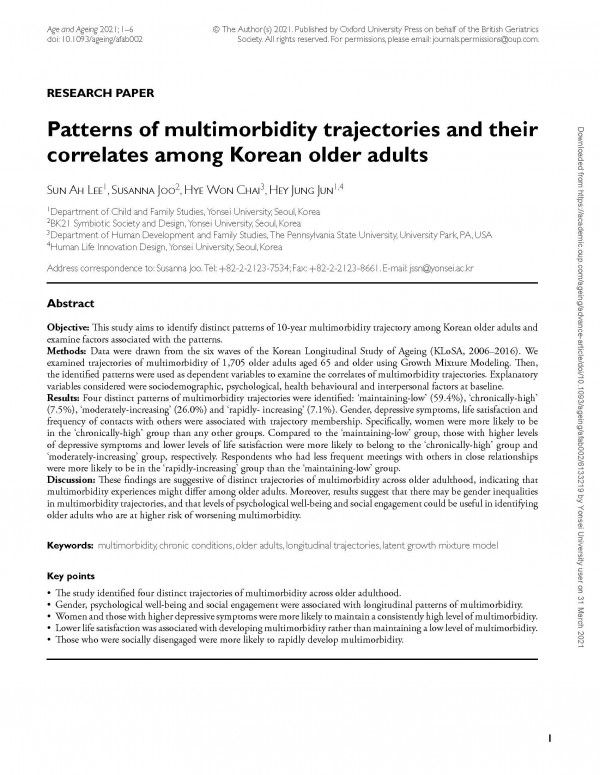논문 | Patterns of multimorbidity trajectories and their correlates among Kor…
페이지 정보
작성자 관리자 작성일21-03-31 14:37 조회483회 댓글0건관련링크
본문
Sun Ah Lee, Susanna Joo, Hye Won Chai, & Hey Jung Jun. (2021). Patterns of multimorbidity trajectories and their correlates among Korean older adults. Age and Ageing.
DOI: https://doi.org/10.1093/ageing/afab002
ABSTRACT
Objective
This study aims to identify distinct patterns of 10-year multimorbidity trajectory among Korean older adults and examine factors associated with the patterns.
Methods
Data were drawn from the six waves of the Korean Longitudinal Study of Ageing (KLoSA, 2006–2016). We examined trajectories of multimorbidity of 1,705 older adults aged 65 and older using Growth Mixture Modeling. Then, the identified patterns were used as dependent variables to examine the correlates of multimorbidity trajectories. Explanatory variables considered were sociodemographic, psychological, health behavioural and interpersonal factors at baseline.
Results
Four distinct patterns of multimorbidity trajectories were identified: ‘maintaining-low’ (59.4%), ‘chronically-high’ (7.5%), ‘moderately-increasing’ (26.0%) and ‘rapidly- increasing’ (7.1%). Gender, depressive symptoms, life satisfaction and frequency of contacts with others were associated with trajectory membership. Specifically, women were more likely to be in the ‘chronically-high’ group than any other groups. Compared to the ‘maintaining-low’ group, those with higher levels of depressive symptoms and lower levels of life satisfaction were more likely to belong to the ‘chronically-high’ group and ‘moderately-increasing’ group, respectively. Respondents who had less frequent meetings with others in close relationships were more likely to be in the ‘rapidly-increasing’ group than the ‘maintaining-low’ group.
Discussion
These findings are suggestive of distinct trajectories of multimorbidity across older adulthood, indicating that multimorbidity experiences might differ among older adults. Moreover, results suggest that there may be gender inequalities in multimorbidity trajectories, and that levels of psychological well-being and social engagement could be useful in identifying older adults who are at higher risk of worsening multimorbidity.
